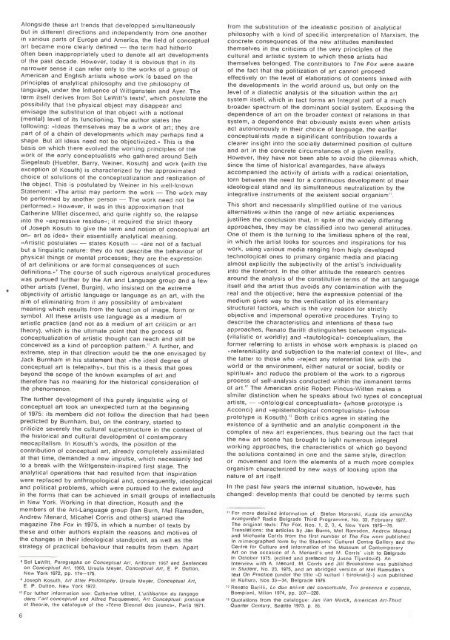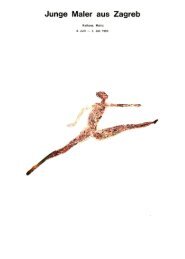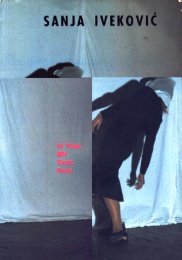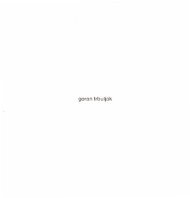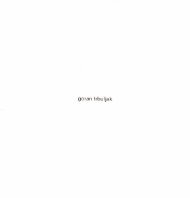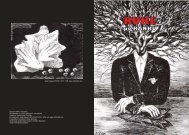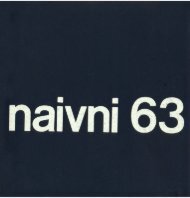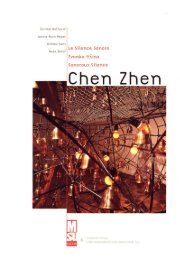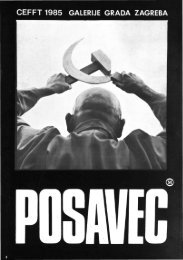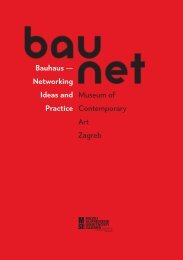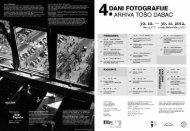The New Art Practice in Yugoslavia, 1966-1978
The New Art Practice in Yugoslavia, 1966-1978
The New Art Practice in Yugoslavia, 1966-1978
- TAGS
- practice
- yugoslavia
- www.msu.hr
Create successful ePaper yourself
Turn your PDF publications into a flip-book with our unique Google optimized e-Paper software.
Alongside these art trends that developped simultaneously<br />
but <strong>in</strong> different directions and <strong>in</strong>dependently from one another<br />
<strong>in</strong> various parts of Europe and America, the field of conceptual<br />
art became more clearly def<strong>in</strong>ed the term had hitherto<br />
often been <strong>in</strong>appropriately used to denote all art developments<br />
of the past decade. However, today it is obvious that <strong>in</strong> its<br />
narrower sense it can refer only to the works of a group of<br />
American and English artists whose work is based on the<br />
pr<strong>in</strong>ciples of analytical philosophy and the philosophy of<br />
language, under the <strong>in</strong>fluence of Wittgenste<strong>in</strong> and Ayer. <strong>The</strong><br />
term itself derives from Sol LeWitt's texts', which postulate the<br />
possibility that the physical object may disappear and<br />
envisage the substitution of that object with a notional<br />
(mental) level of its function<strong>in</strong>g. <strong>The</strong> author states the<br />
follow<strong>in</strong>g: «Ideas themselves may be a work of art; they are<br />
part of of a cha<strong>in</strong> of developments which may perhaps f<strong>in</strong>d a<br />
shape. But all ideas need not be objectivized, This is the<br />
basis on which there evolved the work<strong>in</strong>g pr<strong>in</strong>ciples of the<br />
work of the early conceptualists who gathered around Seth<br />
Siegelaub (Huebler, Barry, We<strong>in</strong>er, Kosuth) and work (with the<br />
exception of Kosuth) is characterized by the approximated<br />
choice of solutions of the conceptualization and realization of<br />
the object. This is postulated by We<strong>in</strong>er <strong>in</strong> his well-known<br />
Statement: «<strong>The</strong> artist may perform the work <strong>The</strong> work may<br />
be performed by another person <strong>The</strong> work need not be<br />
performed.. However, it was <strong>in</strong> this approximation that<br />
Cather<strong>in</strong>e Millet discerned, and quite rightly so, the relapse<br />
<strong>in</strong>to the «expressive residue.: it required the strict theory<br />
of Joseph Kosuth to give the term and notion of conceptual art<br />
on. art as idea» their essentially analytical mean<strong>in</strong>g.<br />
«<strong>Art</strong>istic postulates states Kosuth «are not of a factual<br />
but a l<strong>in</strong>guistic nature: they do not describe the behaviour of<br />
physical th<strong>in</strong>gs or mental processes; they are the expression<br />
of art def<strong>in</strong>itions or are formal consequences of such<br />
def<strong>in</strong>itions,' <strong>The</strong> course of such rigorous analytical procedures<br />
was pursued further by the <strong>Art</strong> and Language group and a few<br />
other artists (Venet. Burg<strong>in</strong>), who <strong>in</strong>sisted on the extreme<br />
objectivity of artistic language or language as an art, with the<br />
aim of elim<strong>in</strong>at<strong>in</strong>g from it any possibility of ambivalent<br />
mean<strong>in</strong>g which results from the funct.on of image, form or<br />
symbol. All these artists use language as a medium of<br />
artistic practice (and not as a medium of art criticim or art<br />
theory), which is the ultimate po<strong>in</strong>t that the process of<br />
conceptualization of artistic thought can reach and still be<br />
conceived as a k<strong>in</strong>d of perception pattern. A further, and<br />
extreme, step <strong>in</strong> that direction would be the one envisaged by<br />
Jack Burnham <strong>in</strong> his statement that «the ideal degree of<br />
conceptual art is telepathy., but this is a thesis that goes<br />
beyond the scope of the known examples of art and<br />
therefore has no mean<strong>in</strong>g for the historical consideration of<br />
the phenomenon.<br />
<strong>The</strong> further development of this purely l<strong>in</strong>guistic w<strong>in</strong>g of<br />
conceptual art took an unexpected turn at the beg<strong>in</strong>n<strong>in</strong>g<br />
of 1975: its members did not follow the direction that had been<br />
predicted by Burnham, but, on the contrary, started to<br />
criticize severely the cultural superstructure <strong>in</strong> the context of<br />
the historical and cultural development of contemporary<br />
neocapitalism. In Kosuth's words, the position of the<br />
contribution of conceptual art, already completely assimilated<br />
at that time, demanded a new impulse, which necessarily led<br />
to a break with the Wittgenste<strong>in</strong>-<strong>in</strong>spired first stage. <strong>The</strong><br />
analytical operations that had resulted from that <strong>in</strong>spiration<br />
were replaced by anthropological and, consequently, ideological<br />
and political problems, which were pursued to the extent and<br />
<strong>in</strong> the forms that can be achieved <strong>in</strong> small groups of <strong>in</strong>tellectuals<br />
<strong>in</strong> <strong>New</strong> York. Work<strong>in</strong>g <strong>in</strong> that direction, Kosuth and the<br />
members of the <strong>Art</strong>-Language group (Ian Burn, Mel Ramsden,<br />
Andrew Menard, Micahel Corns and others) started the<br />
magaz<strong>in</strong>e <strong>The</strong> Fox <strong>in</strong> 1975, <strong>in</strong> which a number of texts by<br />
these and other authors expla<strong>in</strong> the reasons and motives of<br />
the changes <strong>in</strong> their ideological standpo<strong>in</strong>t, as well as the<br />
strategy of practical behaviour that results from them. Apart<br />
°Sot LeWitt, Paragraphs on Conceptual <strong>Art</strong>, <strong>Art</strong>forum 1967 and Sentences<br />
on Conceptual <strong>Art</strong>, 1968. Ursula Meyer, Conceptual <strong>Art</strong>, E. P. Dutton,<br />
<strong>New</strong> York 1972. pp. 174-175.<br />
°Joseph Kosuth. <strong>Art</strong> Alter Philosophy, Ursula Meyer, Conceptual <strong>Art</strong>,<br />
E. P. Dutton, <strong>New</strong> York 1972.<br />
w For futher <strong>in</strong>formation see: Cather<strong>in</strong>e Millet. L'utilisation du !engage<br />
dans fart conceptuel and Alfred Pacguement. <strong>Art</strong> Conceptual: pratique<br />
et theorie, the catalogue of the .7ame Biennal des jeunes.. Paris 1971.<br />
6<br />
from the substitution of the idealistic position of analytical<br />
philosophy with a k<strong>in</strong>d of specific <strong>in</strong>terpretation of Marxism, the<br />
concrete consequences of the new attitudes manifested<br />
themselves <strong>in</strong> the criticims of the very pr<strong>in</strong>ciples of the<br />
cultural and artistic system to which these artists had<br />
themselves belonged <strong>The</strong> contributors to <strong>The</strong> Fox were aware<br />
of the fact that the politization of art cannot proceed<br />
effectively on the level of elaborations of contents l<strong>in</strong>ked with<br />
the developments <strong>in</strong> the world around us, but only on the<br />
level of a dialectic analysis of the situation with<strong>in</strong> the art<br />
system itself, which <strong>in</strong> fact forms an <strong>in</strong>tegral part of a much<br />
broader spectrum of the dom<strong>in</strong>ant social system. Expos<strong>in</strong>g the<br />
dependence of art on the broader context of relations <strong>in</strong> that<br />
system, a dependence that obviously exists even when artists<br />
act autonomously <strong>in</strong> their choice of language, the earlier<br />
conceptualists made a sig<strong>in</strong>ificant contribution towards a<br />
clearer <strong>in</strong>sight <strong>in</strong>to the socially determ<strong>in</strong>ed position of culture<br />
and art <strong>in</strong> the concrete circumstances of a given reality.<br />
However, they have not been able to avoid the dilemmas which,<br />
s<strong>in</strong>ce the time of historical avantgardes, have always<br />
accompanied the activity of artists with a radical orientation,<br />
torn between the need for a cont<strong>in</strong>uous development of their<br />
ideological stand and its simultaneous neutralization by the<br />
<strong>in</strong>tegrative <strong>in</strong>struments of the existent social organism..<br />
This short and necessarily simplified outl<strong>in</strong>e of the various<br />
alternatives with<strong>in</strong> the range of new artistic experiences<br />
justifies the conclusion that, <strong>in</strong> spite of the widely differ<strong>in</strong>g<br />
approaches, they may be classified <strong>in</strong>to two general attitudes.<br />
One of them is the turn<strong>in</strong>g to the limitless sphere of the real,<br />
<strong>in</strong> which the artist looks for sources and <strong>in</strong>spirations for his<br />
work, us<strong>in</strong>g various media rang<strong>in</strong>g from higly developed<br />
technological ones to primary organic media and plac<strong>in</strong>g<br />
almost explicitly the subjectivity of the artist's <strong>in</strong>dividuality<br />
<strong>in</strong>to the forefront. In the other attitude the research centres<br />
around the analysis of the constitutive terms of the art language<br />
itself and the artist thus avoids any contam<strong>in</strong>ation with the<br />
real and the objective: here the expressive potential of the<br />
medium gives way to the verification of its elementary<br />
structural factors, which is the very reason for strictly<br />
objective and impersonal operative procedures. Try<strong>in</strong>g to<br />
describe the characteristics and <strong>in</strong>tentions of these two<br />
approaches, Renato BariIli dist<strong>in</strong>guishes between «mystical.<br />
(vitalistic or worldly) and «tautological» conceptualism, the<br />
former referr<strong>in</strong>g to artists <strong>in</strong> whose work emphasis is placed on<br />
«referenitiality and subjection to the material context of life., and<br />
the latter to those who «reject any referential l<strong>in</strong>k with the<br />
world or the environment, either natural or social, bodily or<br />
spiritual» and reduce the problem of the work to a rigorous<br />
process of self-analysis conducted with<strong>in</strong> the immanent terms<br />
of art.' <strong>The</strong> American critic Robert P<strong>in</strong>cus-Witten makes a<br />
similar dist<strong>in</strong>ction when he speaks about two types of conceptual<br />
artists, «ontological conceptualists. (whose prototype is<br />
Acconci) and «epistemological conceptualists. (whose<br />
prototype is Kosuth).' Both critics agree <strong>in</strong> stat<strong>in</strong>g the<br />
existence of a synthetic and an analytic component <strong>in</strong> the<br />
complex of new art experiences, thus bear<strong>in</strong>g out the fact that<br />
the new art scene has brought to light numerous <strong>in</strong>tegral<br />
work<strong>in</strong>g approaches, the characteristics of which go beyond<br />
the solutions conta<strong>in</strong>ed <strong>in</strong> one and the same style, direction<br />
or movement and form the elements of a much more complex<br />
organism characterized by new ways of look<strong>in</strong>g upon the<br />
nature of art itself.<br />
In the past few years the <strong>in</strong>ternal situation, however, has<br />
changed: developments that could be denoted by terms such<br />
For more detailed <strong>in</strong>formation cf.: Stefan Moravski, Kuda ide arneridka<br />
avangarda? Radio Belgrade Third Programme. No 33, February 1977.<br />
<strong>The</strong> orig<strong>in</strong>al texts: <strong>The</strong> Fox, Nos. 1, 2. 3. 4. <strong>New</strong> York 1975-76.<br />
Translations: the articles by Jan Burns. Mel Rarnsden, Andrew Menard<br />
and Michaele Corns from the first number of <strong>The</strong> Fox were published<br />
<strong>in</strong> mimeographed form by the Students' Cultural Centre Gallery and the<br />
Centre for Culture and Information of the Museum of Contemporary<br />
<strong>Art</strong> on the occasion of A. Menard's and M. Corns' visit to Belgrade<br />
<strong>in</strong> October 1975. (edited and prefaced by Jasna Tijardovi). An<br />
Interview with A. Menard, M. Corns and Jill Breakstone was published<br />
<strong>in</strong> Student, No. 23. 1975, and an abridged version of Mel Ramsden's<br />
text On <strong>Practice</strong> (under the title .0 kulturi i birokratiji.) was published<br />
<strong>in</strong> Kultura. Nos 33-34, Belgrade 1976.<br />
'3 Renato Barilli, Le due anime del concettuale, Tra presenza e assenza,<br />
Bornpiani. Milan 1974, pp. 207-228.<br />
'3 Quotations from the catalogue: Jan Van Marck, American <strong>Art</strong>-Third<br />
Quarter Century, Seattle 1973. p. 86.


